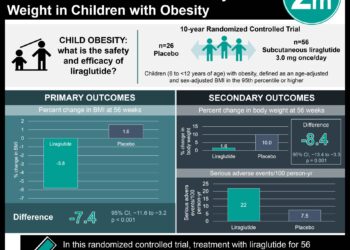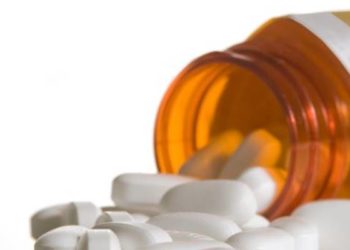The Ellipse trial: liraglutide improves glycemic control in children with type 2 diabetic on metformin
1. In children with type 2 diabetes (T2DM) on metformin, those randomized to liraglutide had better glycemic control after 26 weeks compared to placebo treated patients.
2. Patients treated with liraglutide experienced more adverse events and gastrointestinal issues than placebo patients.
Evidence Rating Level: 1 (Excellent)
Study Rundown: Incidence of both childhood obesity and T2DM are increasing. Metformin is standard treatment for youth with T2DM, though second-line therapies are lacking for children compared to adults with T2DM. The glucagon-like peptide-1 analog liraglutide has shown promise in a phase 2 study in children, and further confirmation of efficacy would add to the possible treatment options for young T2DM patients. The Evaluation of Liraglutide in Pediatrics with Diabetes (Ellipse) trial showed after 26 weeks of treatment, T2DM children on metformin randomized to receive liraglutide experienced better glycemic control than placebo treated patients. Liraglutide treated patients also experienced more overall adverse events and gastrointestinal issues.
This phase 3 study provides rationale for the use of liraglutide in children with T2DM already on metformin for additional glycemic control. Strengths of the study included the randomized design and in-depth adverse event reporting, while it is limited by the length of follow-up only out to 52 weeks and the relatively small number of patients.
Click to read the study, published today in NEJM
Relevant Reading: Prevalence of type 1 and type 2 diabetes among children and adolescents from 2001 to 2009
In-Depth [randomized controlled trial]: This phase 3, international, randomized, placebo controlled trial enrolled patient from 2012 to 2018. Eligible patients were between 10 and 17 years old, had T2DM, had a body mass index (BMI) of greater than the 85th percentile, were treated with metformin (with or without insulin), and had glycated hemoglobin (HbA1c) levels between approximately 6.5 and 11.0%. Those with type 1 diabetes were excluded. Patients had a 11-12 week run-in period were metformin was increased to a maximum tolerated dose between 1000 and 2000mg per day followed by 8 weeks of maintenance. Patients were then randomized to received subcutaneous liraglutide (n=66, starting at 0.6mg/day with a 3-week dose escalation) or placebo (n=68) for 26 weeks in addition to a diet and exercise regimen. More patients in the liraglutide group complete 52-weeks of follow-up. The primary outcome of mean HbA1c at week 26 was reduced 0.64% from baseline in the liraglutide group and 0.42% in the placebo group (estimated treatment difference, −1.06 percentage points; 95% confidence interval [CI], −1.65 to −0.46; P<0.001). At week 52 the HbA1c treatment difference was increased (−1.30 percentage points; 95% CI, −1.89 to −0.70). Subgroup analysis showed no treatment differences across sex or age groups. More patients in the treatment group attained HbA1c levels below 7.0%. No difference in BMI was observed between groups at week 26, but by week 52 an observable decrease in BMI in liraglutide patients was observed. By week 26 mean body weight was decreased in both groups but was only maintained by week 52 in the liraglutide group. The rate of adverse events per 1 patient-year was higher in the liraglutide group. Gastrointestinal adverse events were more common in the treatment group, most notably during the first 8 weeks of treatment.
Image: PD
©2019 2 Minute Medicine, Inc. All rights reserved. No works may be reproduced without expressed written consent from 2 Minute Medicine, Inc. Inquire about licensing here. No article should be construed as medical advice and is not intended as such by the authors or by 2 Minute Medicine, Inc.







